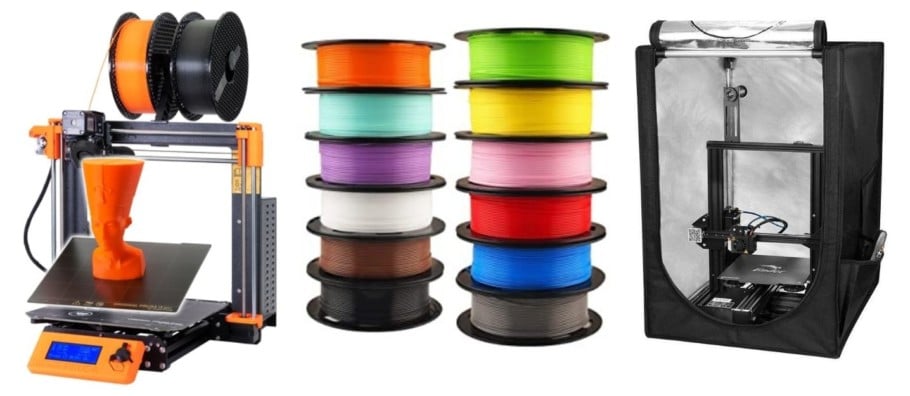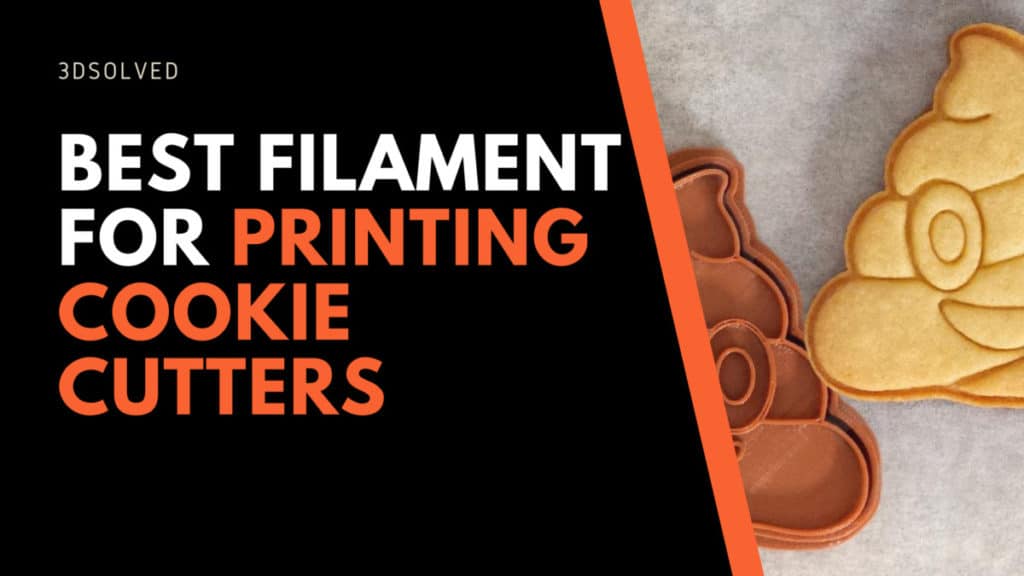We are already familiar with the infinite uses that 3d printing enthusiast re finding every day. It should be of no surprise that this incredible technology has also reached the culinary world in the form of kitchen utensils.
One of the most popular 3D printed parts for kitchen use is none other than cookie cutters, since it allows us to print our own designs. But before we get started printing tons of designs, we should first research if they are safe to use.
Because cookie cutters are only in direct contact with food for a few seconds, most filaments are safe to use for this purpose, but generally speaking, PETG should be your filament of choice since it’s used for making water bottles, etc. and is considered to be the safest type of filament.
You should always keep in mind that most filaments are not dishwasher safe. Additionally, PLA has a low glass transition temperature, which makes it unsuitable to be washed with warm water.
Are 3D printed cookie cutters safe?

Cookie cutters are a great baking tool to bring uniformity to baked treats. The number one rule of any well-run kitchen is good hygiene. This goes beyond clean surfaces and utensils to what can’t be seen with the naked eye. We’re talking bacteria, chemicals, and other non-visible toxins.
Printing your own 3D cookie cutters allows you to create your own unique designs. Getting creative with designs can be just as much fun as baking cookies. But you must always be aware of food safety as not all filament types are food-friendly.
Some filaments may contain chemicals that should not be used with food at all. Any chemical transfer to food will not be neutralized through cooking or baking.
PLA filament is normally considered safe as it is made from organic corn starch but beware of additives in the filament. Additives are used for color and strength and may not be food safe. It is best to check with the manufactures to confirm if their specific filament is food safe.
Normally all food-safe filament will have this boldly printed on the packaging. Only use a filament that has been FDA approved for use with food.
ABS filament contains harmful chemicals and is not food safe at all. Chemicals will seep into food and may cause health complications in the long term. It is best to avoid using ABS anywhere around food. Having said this, it still remains a controversial subject, as some believe that limited use is fine. Either way, you will be the one to make the final choice.
Printing 3D kitchens utensils using filament has to be safe. If there are any risks to your health, you are entitled to know them. It’s best to confirm what filaments are food safe. The little extra homework will give you peace of mind.
Safest filaments for cookie cutters
To stay on the safe side, print with PLA or PETG (preferably PETG) and avoid using ABS and ASA.
Some ABS filaments have been approved by the FDA, so if you really want to use ABS filament, consider finding those specific filaments that have been approved.
Make sure that the filament pigment is not toxic. For example, if using Prusament (Prusa Research), avoid using its army green PLA. A general rule of thumb is to go natural and focus on the purpose rather than your cookie cutter’s look.
Print with 100% infill, lower layer heights, and only models with simple shapes. This is to minimize the amount of food that accumulates on the model since the smoother the finish, the less carryover will occur. You further reduce this risk by applying a coating of FDA-approved epoxy resin. The resin must be completely dry before use as the wet resin is toxic.
Postproceses to make your cookie cutters safer
Because 3D filament printing is layered, the final product’s surface will not be 100% smooth. You will have to correct this in the post-printing phase and even consider a food-safe epoxy to smooth out any crevices.
A good epoxy option for PLA is Polyurethane which is widely available in most home improvement stores. Using epoxy will limit the amount of cross-contamination. Be careful not to scratch the protective epoxy layer when you use your cookie cutter or when you wash it afterward.
Important considerations for printing kitchen utensils
- Use a stainless steel printer nozzle as brass nozzles contain traces of lead. This may not cause much of an issue for single-use items, but small amounts of exposure all add up.
- Do not expose food for prolonged times to the cookie cutter.
- Avoid using a 3D printed object with liquids. For example, making an ice tray.
Only buy filaments from a reputable brand you can actually trust and make sure that they are FDA approved.
Food safety
Food safety is always something that needs to be considered, no matter what implements are used in the process. Toxic chemicals are a major concern, but bad bacteria are a bigger concern as they can cause immediate risk. Chemical and heavy metal toxins in utensils are minimal but build up through time and eventually affect your health.
Due to the nature of the filament printing process, cookie-cutter presents a real bacteria risk. Not having a smooth and sealed surface may cause the bacteria to accumulate on and in the cookie cutters.
Even with an epoxy finish, there will still be a small opportunity for bacteria to settle on the implement. This is concerning to most health-conscious people, so printing for a single-use or limited use is the way to go. Bacteria build-up can lead to unpleasant situations.
On the positive side, if you consider the length of time that a cookie-cutter is in contact with the dough, it should put you at ease about bacteria transfer. But any contact, no matter how short the time, will still transfer some of it.

Which filaments are FDA approved?
Firstly, let’s take a look at what the FDA consider as food safe:
- There must be no migration of harmful substances.
- Does not influence or carry over colours, odours or taste.
- Safe under normal use conditions.
- Must be durable, corrosion-resistant and withstand repeated washing.
- Must have a smooth finish that is easy to clean. There should be no breaks or sharp internal angles.
- Must be resistant to pitting, chipping, crazing, scratching, distortion and decomposition.
- The product must be accessible for inspection.
Any FDA or EU material includes the polymer as well as additives which may contain plasticizers, impact and heat distortion modifiers, UV-stabilizers, flame retardants, anti-fouling, anti-static, anti-slip, foaming and clarifying agents, anti-oxidants, aromatic nucleators, carbon alloys, phosphorescent, fillers, thickeners, chain extenders, metal deactivators, dyes, and a carrier resin.
This may seem like a mouthful, but you should know what your choice of filament contains.
The FDA has approved some PLA, ABS and PETG filaments for use with food. However, there are two points to consider before you go ahead with printing your cookie cutters.
- Does the material leach into the food, or is it the other way around?
- Can the utensil be properly cleaned between usage?
Leaching should be considered as it differs between materials. For example, nylon absorbs acids but is safe for water storage and transportation. ABS is okay with cold or room temperature foods but not for hot foods. Disposable plastic cutlery is mostly made from injection-molded PLA and is only recommended for single use.
Be wary about where your filament was manufactured. Some Asian filaments contain toxic chemicals commonly found in the additives and color pigments used. Lead, cadmium, strontium and other traces of heavy metals have been found.
It’s sound advice to only use reputable US and EU manufactured filament when printing items used with food. It’s also advisable to stay away from toxic color pigments. Rather stick to plain white or natural filament with no added color.
PETG is a better option for longer contact with wet food and can be washed with hot water, but like ABS, it is not considered dishwasher safe. PLA is prone to deforming as it isn’t heat resistant, so you will have to wash it in cold water, which doesn’t do much for good hygiene.
Two food items that are bacteria super spreaders are eggs and raw meat. Cookie dough contains eggs, and for this reason, single or limited use is advisable. Multiple-use can be safe, but the utensils need to be washed thoroughly in soap and warm water, preferably with a strong, safe detergent.
You can find more about FDA’s guidelines and recommendations here. You can also read this paper published in the Journal of Food Science and this other one published in the Journal of Nutrition Education.

Where can you get cookie-cutter models?
Here are some great cookie-cutter designs you can download for free from Thingiverse and MyMiniFactory to fast-track your baking experience.
However, you can always use our own search engine to find printables all over the web!
Create your own cookie cutters
Creating your own cookie cutters is easier than almost any other 3D object. This is because we only need to sketch a 2D object and extrude it vertically in the Z-axis in order for it to have the desired height.
Here is an easy-to-follow tutorial for creating cookie cutters on fusion360. Its awesomely explained, short and really easy to follow along!
As you can see from the tutorial, the process is not complex at all. Things may get more interesting if you want to add features to your cookie-cutter, like indentations in the gingerbread man or bulldog design.
You will notice the filament lines on the base of the bulldog design that give a rippled effect. This will be difficult to clean or sanitize for multiple uses. When designing your own unique cookie cutters, try and keep the design simple and keep function and purpose in mind.
Conclusion
Like I previously mentioned, PETG is the safest material out of all the filaments available and is generally used for making water and soda bottles, and other food-related containers.
PLA is another alternative for cookie cutters but it deforms fairly easily as soon as it is subjected to relatively warm temperatures, making washing it more complicated than PETG.
Check out our recommended products section

We created a recommended products section that will allow you to remove the guesswork and reduce the time spent researching what printer, filament, or upgrades to get, since we know that this can be a very daunting task and which generally leads to a lot of confusion.
We have selected just a handful of 3D printers that we consider to be good for beginners as well as intermediates, and even experts, making the decision easier, and the filaments, as well as the upgrades listed, were all tested by us and carefully selected, so you know that whichever one you choose will work as intended.
Error processing API data.
